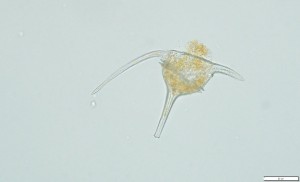
The Importance of Phytoplankton Analysis in Seawater and Biotoxin Effects on Shellfish
Phytoplankton, the microscopic marine plants forming the base of the aquatic food web, play a crucial role in marine ecosystems. Their analysis in seawater is essential for monitoring environmental health, ensuring seafood safety, and assessing the impacts of harmful algal blooms (HABs). One of the major concerns related to phytoplankton is their ability to produce biotoxins that can accumulate in shellfish, posing serious risks to human health
Marine biotoxins, also called phytotoxins or shellfish toxins, are naturally occurring compounds produced by algae and phytoplankton. Under normal conditions these compounds do not cause any problem. However, filter feeders such as clams, mussels, oysters and crustaceans can consume large quantities of these algae when environmental conditions result in harmful algal blooms, also known as ‘Red Tides’. High concentrations of shellfish toxins then accumulate in these animals causing illness amongst people who eat them. There are four syndromes called shellfish poisoning, i.e. paralytic shellfish poisoning (PSP), neurotoxic shellfish poisoning (NSP), diarrhetic shellfish poisoning (DSP) and amnesic shellfish poisoning (ASP). A variety of symptoms are reported to arise from these poisonings, including stomach cramps, abdominal pain, diarrhea, headaches, memory loss, paralysis and in some cases even death. ASP is caused by domoic acid (DA).
Regular phytoplankton analysis in seawater is critical for several reasons:
Early Detection of Harmful Algal Blooms (HABs): HABs, often caused by toxin-producing phytoplankton, can have devastating effects on marine life and human health. Monitoring phytoplankton populations helps in predicting and mitigating the risks associated with HABs.
Marine Biodiversity and Ecosystem Health: By studying phytoplankton diversity and abundance, scientists can assess changes in water quality and detect signs of pollution or climate change impacts.
Shellfish Safety and Public Health: Since shellfish filter-feed on phytoplankton, they can accumulate biotoxins. Regular monitoring helps prevent the harvest and consumption of contaminated shellfish, reducing the risk of poisoning outbreaks.
Fisheries and Aquaculture Management: Phytoplankton analysis assists in managing shellfish farms by providing data on suitable farming conditions and alerting stakeholders to potential threats from toxic algae.
Phytoplankton analysis in seawater is a vital tool for environmental monitoring, seafood safety, and sustainable aquaculture. By regularly assessing phytoplankton populations and their potential to produce harmful biotoxins, scientists and regulatory agencies can mitigate the risks associated with shellfish consumption and protect marine biodiversity. Enhanced monitoring efforts and early-warning systems are key to ensuring the safety of shellfish industries and maintaining the health of marine ecosystems.
